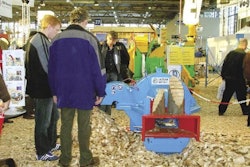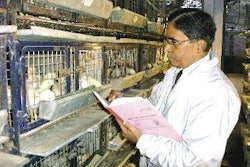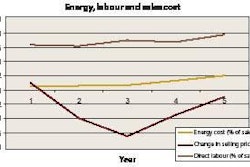French Ambassador Jacques-Andre Costilhes praised the preventative measures taken by the Bangladesh government in tackling H5N1 avian influenza (AI) when it broke out in farms around Dhaka. Nevertheless, the virus still spread southwards into Khulna division bordering West Bengal in India, and into northern Jamalpur district in the large Dhaka division (200km north of Dhaka city).
Noakhali, Khagrachhari and Feni districts of Chittagong division in south-east Bangladesh were initially spared infection and took pre-emptive action, culling birds imported from affected areas and banning transportation of birds, eggs and feed from these areas.
By April 8, H5N1 had infected flocks in Noakhali with 1000 out of 1800 birds on a farm in Companiganj district succumbing to disease and a suspected outbreak on a chicken farm in Khagrachhari district. The disease is still spreading with cumulative outbreaks in five districts of Dhaka division (Dhaka, Narayanganj, Gazipur, Tangail and Jamalpur), Khulna (Bagherat district) and Chittagong (Noakhali district). Bangladesh is a small country and nowhere is far from an international border. Jamalpur in particular is close to the border with India.
India put the entire north-east region on ‘red alert’ not only because of the H5N1 threat from Bangladesh but also from Myanmar. The Indian states of West Bengal, Meghalaya and Tripura share a border with Bangladesh, while Mizoram, Nagaland, Manipur and Arunachal Pradesh border Myanmar.
Indian veterinary authorities consider overall the long-term threat to be greater on this side of India than in the west. In spite of widespread bans and restrictions on formal trade, there is considerable ‘informal’ poultry trade across India’s borders with Bangladesh and Myanmar that central and state government finds difficult to control.
Since the very first reported outbreak in Bangladesh at the state-run Biman Poultry Complex in Savar (outskirts of Dhaka) at least 40,000 chickens have been culled and as many eggs destroyed in Savar and nearby Gazipur district (north-east of Dhaka). These are two main centres of the Bangladeshi poultry industry. According to the District Livestock Office in Gazipur, there are 7135 layer farms and 5336 broiler farms with a total poultry population of 27 million birds in this district.
Government officials tried to play down deaths of thousands of chickens in Narayanganj (south-east of Dhaka) and Jamalpur districts but evidence reported by local media like The Daily Star looked overwhelming. Countrywide cull is now approaching 100,000 birds.
Livestock department teams from Dhaka city sped north to Jamalpur district and culled poultry within the Sharishabari district. Chickens were packed into large jute sacks and buried in ditches. Correspondents in Jamalpur claim some farms had experienced large numbers of sick and dying chickens as long as 6 weeks before the announcement of the first outbreak in Savar.
Instructions were issued to cull all birds at a farm in Narayanganj district after reports of 5000 chickens dying unexpectedly. Local newspaper reports claimed the farm recently received 10,000 chicks from a supplier in Savar and most of these had already died. Managers at the farm in Savar where H5N1 was first identified said over 100,000 chicks were despatched to 58 farms all over Bangladesh between 4 February and 3 March.
Rapid notification of so many infected flocks in central and northern Bangladesh so soon after confirmation of the outbreak in Savar is extraordinary. The pattern supports claims by local media that significant poultry deaths were being reported by producers weeks ago but they were ignored or ascribed to Newcastle disease, a common local disease problem in poultry. Once government had confirmed H5N1, farms with ongoing outbreaks previously not identified as H5N1 appear to have been re-evaluated and acted upon.
With an overall value of US$2 billion, production turnover at $750 million and anything between 5 and 10 million people gaining at least some earnings from the industry, poultry production and marketing is a way of life in Bangladesh.
It is a major supplier of food for 147 million Bangladeshis and has been providing valuable foreign exchange earnings. Bangladesh was one of just several countries in the whole of Asia not to have recorded H5N1.
Bangladesh had been playing on this strength and exporting poultry products increasingly far and wide. M.A. Saleque (Secretary General of the Bangladesh Branch of the World Science Poultry Association) told the Daily Star of poultry exports going into north-east India, Nepal, the Middle East and even some European countries by ‘cashing in’ on the country’s reputation for remaining H5N1-free. The ongoing outbreak will hit this effort hard.
He went on to explain how the industry, growing at some 50-60 percent per year, is underpinned by considerable financial credit from private and government sources, and how lending organisations may now face difficulties in recovery.
The government said it will compensate affected farmers and some farms have already submitted claims. Others say they have received no assurances, being told compensation will be discussed later although they have already lost their flocks. There are already suggestions of false claims and threats by government to prosecute farmers who have failed to disclose information on infected poultry.
Chicken prices in Naraynagani district fell by up to 30 percent in the two days after H5N1 confirmation, and the jobs of up to half a million poultry workers nationwide are under threat.
Journalists from the Daily Star witnessed the cull at one farm, reporting government and farm workers catching and killing chickens without even the most basic safety equipment including gloves, masks and aprons. Culled birds were buried in a hole near the poultry shed which could threaten the integrity of any re-stocking programme.
Initially the Bangladesh government appeared extraordinarily relaxed about the outbreak. C.S. Karim, adviser to the Ministry of Agriculture and Livestock told journalists, “Bird flu spread in other countries like a forest fire. But here we are finding it in pockets.” In reply to a question, he said the government might ask for assistance from the international community. The Asian Development Bank subsequently began to help Bangladesh pool resources and respond more effectively to outbreaks.
Ministry of Health Secretary, Ehsan Ul Fattah, told Reuters, “There is no human infection of the avian flu.” This is part of an increasing trend to use presence/absence of human cases as sole measure of seriousness even though H5N1 may be destroying the poultry industry and mutating along the way. Unless Bangladesh gets to grips with H5N1 in poultry, there will almost certainly be human cases soon.


















